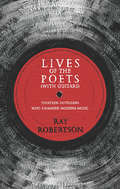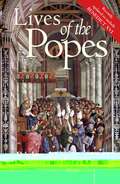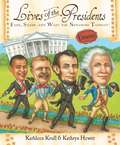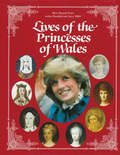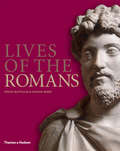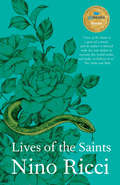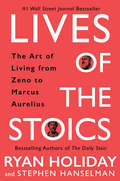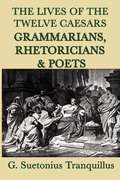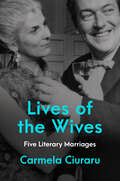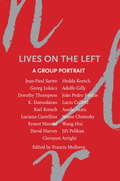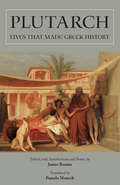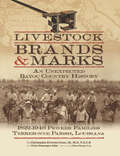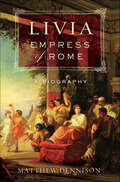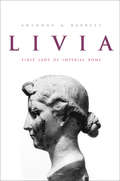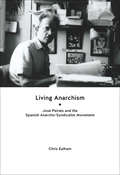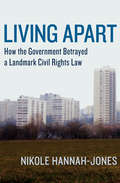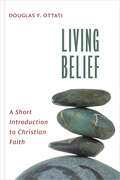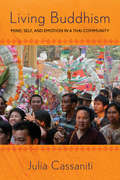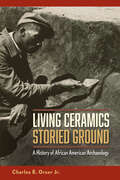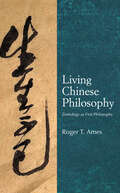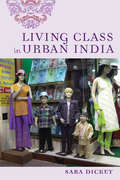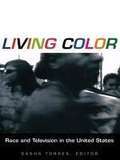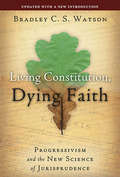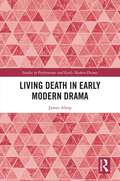- Table View
- List View
Lives of the Poets (with Guitars): Thirteen Outsiders Who Changed Rock & Roll
by Ray Robertson"The days of poets moping around castle steps wearing black capes is over. The poets of today are amplified."- LEONARD COHENPicking up where Samuel Johnson left off more than two centuries ago, Ray Robertson's Lives of the Poets (with Guitars) offers up an amplified gathering of thirteen portraits of rock & roll, blues, folk, and alt-country's most inimitable artists. Irreverent and riotous, Robertson explores the "greater or lesser heat" with which each musician shaped their genre, while offering absorbing insight into their often tumultuous lives.Includes essays on Gene Clark, Ronnie Lane, The Ramones, Sister Rosetta Tharpe, Townes Van Zandt, Little Richard, Alan Wilson, Willie P. Bennett, Gram Parsons, Hound Dog Taylor, Paul Siebel, Willis Alan Ramsey, and John Hartford.
Lives of the Popes
by Richard P. McbrienLives of the Popes is the most thorough, vivid, and fascinating history of the papacy available. Renowned Catholic commentator Richard McBrien offers a fresh, intelligent look at each of the 262 popes, including: -- The Apostle Peter, the first pope, in his singular role as Vicar of Christ-- Formosus, the pope whose corpse was exhumed, dressed in full vestments, and subjected to a mock trial for papal misdeeds-- Boniface, elected pope after having been defrocked twice for immorality-- John XXIII, perhaps the most beloved pope in all of history-- John Paul II, the present Bishop of RomeLives of the Popes provides chronologically arranged biographies of the pontiffs, revealing the full sweep of the papacy. Each entry contains essential information on a pontiffs life, major writings, controversies, and deeds both great and evil. McBrien eloquently and powerfully brings to life the unique stories of the popes and reveals how they transformed Christianity and the world.
Lives of the Presidents
by Kathleen Krull Kathryn HewittEvery U.S. president is the focus of public scrutiny, but how well do we know these men? What kind of fathers do presidents make? Husbands? Neighbors? <P><P>Other books focus on the historical achievements of those who have occupied our country's highest office; Lives of the Presidents looks instead at their bad habits, silly nicknames, and strange pets. Every president--from George Washington to Bill Clinton--is included, with an emphasis on those who have had the greatest impact on history. <P><P>Discover their high points, low points, and the times in between. In this stunning addition to their acclaimed series, Kathleen Krull and Kathryn Hewitt take us beyond politics and photo opportunities, revealing the entertaining, complex, and very real lives of the presidents.
Lives of the Princesses of Wales
by Mary Beacock Fryer Arthur Bousfield Garry ToffoliBeautifully illustrated, this book looks at the nine women who have been Princesses of Wales. From Joan, the "Fair Maid of Kent," through the tragic Katharine of Aragon, Henry’s VIII’s first wife, and the tempestuous Caroline of Brunswick, the mistreated wife of George IV, to the present fairy-tale, headline-catching Princess, their stories are told with insight and compassion.
Lives of the Romans
by Philip Matyszak Joanne BerryOne hundred biographies reveal the mightiest civilization of the ancient world through the lives of its citizens. At its peak Rome's empire stretched across Europe, Africa, and the Middle East, yet it started as a primitive encampment above a riverside marsh. This book spans the great chronological and geographical sweep of the Roman age and brings the reader face to face with those who helped create the empire, from consuls and commanders to ordinary soldiers, voters, and taxpayers. An extraordinary range of viewpoints is explored in these biographies. A centurion and a plasterer's wife share pages with the orator Cicero and the scholar Pliny the Elder, while a vestal virgin shares a chapter with Antinous, the boy-lover of Hadrian. Augustine, the church patriarch, and Constantine, Rome's first "Christian" emperor, rub shoulders with Julian the Apostate and Vettius Agorius Praetextatus, leader of the pagans. Roman women were the most liberated in the ancient world. They could wield massive power and influence, yet are often overlooked. Meet Servilia, Caesar's lover; Sulpicia, the teenage poet; Amazonia, the sword-swinging gladiator; and Cloelia, the girl who escaped captivity by swimming the Tiber. Lavishly illustrated with magnificent works of art, including portraits, sculptures, and Renaissance paintings of Roman scenes, this book reveals the real-life stories behind the rise and fall of Rome. Philip Matyszak teaches Roman History for the Institute of Continuing Education at Cambridge. He has written extensively on the ancient world. Joanne Berry teaches ancient history at Swansea University and is the author of The Complete Pompeii.
Lives of the Saints (Lives of the Saints Series #1)
by Nino RicciWhen young Vittorio Innocente&’s mother, Cristina, is bitten by a snake in the family stable, no one sees the blue-eyed stranger leaving except for Vittorio. He struggles to keep his mother&’s secret but secrets in a small village are hard to keep, and while Cristina&’s belly gradually grows under her loose dresses, they find themselves shunned by their superstitious neighbours. A classic of Canadian literature, Lives of the Saints has earned many distinctions since it was originally published in 1990. It was a national bestseller for seventy-five weeks, received the Governor Generals Literary Award for Fiction, the W.H. Smith / Books in Canada First Novel Award, and the F.G. Bressani Prize. In England it won the Betty Trask Award and Winifred Holtby Memorial Prize, in the U.S. was shortlisted for the Los Angeles Times Art Seidenbaum Award for First Fiction, and in France was an Oeil de la letter Selection of the National Libraries Association. It was also adapted into a miniseries starring Sophia Loren.
Lives of the Stoics: The Art of Living from Zeno to Marcus Aurelius
by Ryan Holiday Stephen HanselmanFrom the bestselling authors of The Daily Stoic comes an inspiring guide to the lives of the Stoics, and what the ancients can teach us about happiness, success, resilience and virtue.Nearly 2,300 years after a ruined merchant named Zeno first established a school on the Stoa Poikile of Athens, Stoicism has found a new audience among those who seek greatness, from athletes to politicians and everyone in between. It's no wonder; the philosophy and its embrace of self-mastery, virtue, and indifference to that which we cannot control is as urgent today as it was in the chaos of the Roman Empire. In Lives of the Stoics, Holiday and Hanselman present the fascinating lives of the men and women who strove to live by the timeless Stoic virtues of Courage. Justice. Temperance. Wisdom. Organized in digestible, mini-biographies of all the well-known--and not so well-known--Stoics, this book vividly brings home what Stoicism was like for the people who loved it and lived it, dusting off powerful lessons to be learned from their struggles and successes. More than a mere history book, every example in these pages, from Epictetus to Marcus Aurelius--slaves to emperors--is designed to help the reader apply philosophy in their own lives. Holiday and Hanselman unveil the core values and ideas that unite figures from Seneca to Cato to Cicero across the centuries. Among them are the idea that self-rule is the greatest empire, that character is fate; how Stoics benefit from preparing not only for success, but failure; and learn to love, not merely accept, the hand they are dealt in life. A treasure of valuable insights and stories, this book can be visited again and again by any reader in search of inspiration from the past.
Lives of the Twelve Caesars: Grammarians, Rhetoricians & Poets
by G. Surtonius TranquillusThe Twelve Caesars is a set of twelve biographies of Julius Caesar and the first 11 emperors of the Roman Empire written by Gaius Suetonius Tranquillus. The work, written in AD 121 during the reign of the emperor Hadrian, was the most popular work of Suetonius, at that time Hadrian's personal secretary, and is the largest among his surviving writings. The Twelve Caesars is considered very significant in antiquity and remains a primary source on Roman history.
Lives of the Wives: Five Literary Marriages
by Carmela Ciuraru"The five marriages that Carmela Ciuraru explores in Lives of the Wives provide such delightfully gossipy pleasure that we have to remind ourselves that these were real people whose often stormy relationships must surely have been less fun to experience than they are for us to read about."—Francine Prose, author of The VixenA witty, provocative look inside the tumultuous marriages of five writers, illuminating the creative process as well as the role of money, power, and fame in these complex and fascinating relationships."With an ego the size of a small nation, the literary lion is powerful on the page, but a helpless kitten in daily life—dependent on his wife to fold an umbrella, answer the phone, or lick a stamp."The history of wives is largely one of silence, resilience, and forbearance. Toss in celebrity, male privilege, ruthless ambition, narcissism, misogyny, infidelity, alcoholism, and a mood disorder or two, and it's easy to understand why the marriages of so many famous writers have been stormy, short-lived, and mutually destructive. "It's been my experience," as the critic and novelist Elizabeth Hardwick once wrote, "that nobody holds a man's brutality to his wife against him." Literary wives are a unique breed, requiring a particular kind of fortitude.Author Carmela Ciuraru shares the stories of five literary marriages, exposing the misery behind closed doors. The legendary British theatre critic Kenneth Tynan encouraged his American wife, Elaine Dundy, to write, then watched in a jealous rage as she became a bestselling author and critical success. In the early years of their marriage, Roald Dahl enjoyed basking in the glow of his glamorous movie star wife, Patricia Neal, until he detested her for being the breadwinner, and being more famous than he was. Elizabeth Jane Howard had to divorce Kingsley Amis to escape his suffocating needs and devote herself to her own writing. ("I really couldn't write very much when I was married to him," she once recalled, "because I had a very large household to keep up and Kingsley wasn't one to boil an egg, if you know what I mean.") Surprisingly, the most traditional partnership in Lives of the Wives is a lesbian couple, Una Troubridge and Radclyffe Hall, both of whom were socially and politically conservative and unapologetic snobs.As this erudite and entertaining work shows, each marriage is a unique story, filled with struggles and triumphs and the negotiation of power. The Italian novelists Elsa Morante and Alberto Moravia were never sexually compatible, and it was Morante who often behaved abusively toward her cool, detached husband, even as he unwaveringly admired his wife's talents and championed her work. Theirs was an unhappy union, yet it fueled them creatively and enabled both to become two of Italy's most important postwar writers.These are stories of vulnerability, loneliness, infidelity, envy, sorrow, abandonment, heartbreak, and forgiveness. Above all, Lives of the Wives honors the women who have played the role of muses, agents, editors, proofreaders, housekeepers, gatekeepers, amaneunses, confidantes, and cheerleaders to literary trailblazers throughout history. In revisiting the lives of famous writers, it is time in our #MeToo era to highlight the achievements of their wives—and the price these women paid for recognition and freedom. Lives of the Wives is an insightful, humorous, and poignant exploration of the intersection of life and art and creativity and love.
Lives on the Left
by Noam Chomsky Luciana Castellina Giovanni Arrighi Francis Mulhern Akira AsadaThe extended critical interview is especially flexible as a form, by turns tenacious and glancing, elliptical or sustained, combining argument and counter-argument, reflection, history and memoir with a freedom normally denied to its subjects in conventional writing formats. Lives on the Left brings together sixteen such interviews from New Left Review in a group portrait of intellectual engagement in the twentieth century and since.Four generations of intellectuals discuss their political histories and present perspectives, and the specialized work for which they are, often, best known. Their recollections span the century from the Great War and the October Revolution to the present, ranging across Europe, the Americas, Africa and Asia. Psychoanalysis, philosophy, the gendering of private and public life, capital and class formation, the novel, geography, and language are among the topics of theoretical discussion. At the heart of the collection, in all its diversity of testimony and judgement, is critical experience of communism and the tradition of Marx, relayed now for a new generation of readers.Lives on the Left includes interviews with Georg Lukács, Hedda Korsch, Jean-Paul Sartre, Dorothy Thompson, Jiri Pelikan, Ernest Mandel, Luciana Castellina, Lucio Colletti, K. Damodaran, Noam Chomsky, David Harvey, Adolfo Gilly, João Pedro Stédile, Asada Akira, Wang Hui and Giovanni Arrighi.New Left Review was founded in 1960 in London, which has remained its base ever since. In fifty years of publication, it has won an international reputation as an independent journal of socialist politics and ideas, attracting readers and contributors from every part of the world. A Spanish-language edition is published bi-monthly from Madrid.
Lives that Made Greek History
by Plutarch James Romm Pamela MenschAlthough Plutarch did not intend his Lives as a historical record, they sometimes furnish the best account we have of events in classical Greece. In many instances they are the only account available to those exploring ancient history through primary sources.In this compilation from Plutarch's Greek Lives, James Romm gathers the material of greatest historical significance from fifteen biographies, ranging from Theseus in earliest times to Phocion in the late fourth century BCE. While preserving the outlines of Plutarch's character portraits, Romm focuses on the central stories of classical Greece: the rivalry between Athens, Sparta, and Thebes, the rise of Macedon, andthe conflicts between these European states and the Achaemenid Persian empire. Bridging Plutarch's gaps with concise summaries, Romm creates a coherent narrative of the classical Greek world.This edition features the elegant new translation of Pamela Mensch. Footnotes provide the historical context often omitted by Plutarch and plentiful and detailed cross-references. Also included are a bibliography, maps, a chronological chart, a glossary, and an index.
Livestock Brands and Marks: An Unexpected Bayou Country History: 1822–1946 Pioneer Families: Terrebonne Parish, Louisiana
by Christopher Everette Cenac Sr.A 2014 Humanities Book of the YearResearching the original brand registration of his great-grandfather Pierre Cenac for his book Eyes of an Eagle, Dr. Christopher Everette Cenac Sr. discovered a serendipitous trove of local history in the form of long-forgotten volumes in the Terrebonne Parish Courthouse in Houma, Louisiana. The three ledger books that emerged through the efforts of the local Clerk of Court became, in themselves, a series of capsulized glimpses into the citizenry of the area's early agrarian foundations. In extraordinary condition, these ledgers held an unprecedented set of the original livestock brands and marks of bustling bayou cattle country.Each registration entry furnished a record of the progression of settlement of the parish. The registration of a brand often served as the family's calling card upon making Terrebonne Parish their home. Livestock Brands and Marks: An Unexpected Bayou Country History: 1822-1946 Pioneer Families: Terrebonne Parish, Louisiana is designed not only to share the actual registration treasures of all 1140 brands in the brand books themselves, but also to chronicle a short history of laws governing animal identification, to document advances in forms of ownership identification, and to familiarize the reader with both ancient and more recent livestock breeds that received brands and other marks recorded in those three ledger books. Three hundred black-and-white and color illustrations illuminate this fascinating history.
Livia, Empress of Rome: A Biography
by Matthew DennisonRome is a subject of endless fascination, and in this new biography of the infamous Empress Livia, Matthew Dennison brings to life a woman long believed to be one of the most feared villainesses of history.Second wife of the emperor Augustus, mother of his successor Tiberius, grandmother of Claudius and great grandmother of Caligula, the empress Livia lived close to the center of Roman political power for eight turbulent decades. Her life spanned the years of Rome's transformation from Republic to Empire, and witnessed both its triumphs under the rule of Augustus and its lapse into instability under his dysfunctional successor.Livia was given the honorific title Augusta in her husband's will, and was posthumously deified by the emperor Claudius—but posterity would prove less respectful. The Roman historian Tacitus anathematized her as "malevolent" and a "feminine bully" and inspired Robert Graves's celebrated twentieth-century depiction of Livia in I, Claudius as the quintessence of the scheming matriarch, poisoning her relatives one by one to smooth her son's path to the imperial throne.Livia, Empress of Rome rescues the historical Livia from the crude caricature of popular myth to paint an elegant and richly textured portrait. In this rigorously researched biography, Dennison weighs the evidence found in contemporary sources to present a more nuanced assessment. Livia's true "crime," he reveals, was not murder but the exercise of power. The Livia who emerges here is a complex, courageous and gifted woman, and one of the most fascinating and perplexing figures of the ancient world.
Livia: First Lady of Imperial Rome
by Anthony A. BarrettThe author of Rome Is Burning separates fact from fiction as he examines the life of an ancient Roman figure made famous in the TV miniseries I Claudius.Livia—wife of the first Roman emperor, Caesar Augustus, and mother of the second, Tiberius—wielded extraordinary power at the center of Roman politics. In this biography of Livia, the first in English, Anthony Barrett sets aside the portrait of a cunning and sinister schemer to reveal Livia as a complex figure whose enduring political influence helped shape Roman government long after her death.&“An excellent biography of Livia—as appealing to the general reader as it is satisfying to the scholar.&” —Colin M. Wells, Trinity University, San Antonio&“In reading Anthony Barrett&’s biography of Livia, I not only learned about this remarkable woman, but also gained a meaningful appreciation of life and society in her time.&” —Howard Alper, President, The Royal Society of Canada &“First-rate.&” —Mary Beard, Times Literary Supplement
Living Anarchism
by Chris Ealham"Magnificent. "--Paul Preston, author ofThe Spanish Holocaust Brick maker by trade, revolutionary anarchist and historian by defau Chris Ealhamis the author ofAnarchism and the City: Revolution and Counter-revolution in Barcelona, 1898-1937.
Living Apart
by Nikole Hannah-JonesProPublica's groundbreaking investigation into housing segregation, and the federal government's large-scale failure to uphold the laws meant to prevent itMore than forty years after President Johnson signed the landmark Fair Housing Act into law, residential segregation in America remains unresolved. Designed to help dismantle the nation's racially divided housing patterns, the act has gone largely ignored by every presidential administration--Democrat and Republican alike--since 1968. In Living Apart, ProPublica investigates this failing, particularly how subsequent leaders, following President Nixon's lead, have declined to use the billions in grant dollars awarded by the Department of Housing and Urban Development as leverage to fight segregation. Their reluctance to enforce a law passed by both houses of Congress and repeatedly upheld by the courts reflects a larger political reality. Again and again, attempts to create integrated neighborhoods have foundered This ebook includes an exclusive afterword by the author, as well as an appendix of original documents dating from the Nixon administration, revealing the internal politics swirling around the Fair Housing Act shortly after its enactment.
Living Belief: A Short Introduction to Christian Faith
by Douglas F. OttatiA leading theologian&’s concise guide to the beliefs, commitments, and practices of Christianity. What do Christians believe? But also, what do they do? And feel? With decades of experience teaching the essentials of Christian faith, Douglas Ottati still finds these questions—and more like them—dynamic and compelling. In Living Belief, he moves beyond trite answers, drawing from the deep well of tradition to offer up wisdom from the Apostles&’ Creed, the Ten Commandments, the Sermon on the Mount, and the Lord&’s Prayer. In so doing, Ottati explores key Christian themes, such as creation, redemption, and love—of neighbor, enemy, and the weak and dependent. Concise and approachable, Living Belief makes no claims to be a definitive account of Christianity but rather attempts &“to introduce a faith that remains a source of meaning and direction, that orients, that encourages and assures, that supplies moral standards and calls for contrition, and that furnishes grounds for perseverance and hope.&” In connection with each chapter, Ottati includes questions for discussion, so that readers—those revisiting the core components of their Christian faith and those learning about it for the first time—can together continue the work, begun here, of understanding the multifaceted life of devotion that is Christianity.
Living Buddhism: Mind, Self, and Emotion in a Thai Community
by Julia CassanitiIn Living Buddhism, Julia Cassaniti explores Buddhist ideas of impermanence, nonattachment, and intention as they are translated into everyday practice in contemporary Thailand. Although most lay people find these philosophical concepts difficult to grasp, Cassaniti shows that people do in fact make an effort to comprehend them and integrate them as guides for their everyday lives. In doing so, she makes a convincing case that complex philosophical concepts are not the sole property of religious specialists and that ordinary lay Buddhists find in them a means for dealing with life's difficulties. More broadly, the book speaks to the ways that culturally informed ideas are part of the psychological processes that we all use to make sense of the world around us. In an approachable first-person narrative style that combines interview and participant-observation material gathered over the course of two years in the community, Cassaniti shows how Buddhist ideas are understood, interrelated, and reinforced through secular and religious practices in everyday life. She compares the emotional experiences of Buddhist villagers with religious and cultural practices in a nearby Christian village. Living Buddhism highlights the importance of change, calmness (as captured in the Thai phrase jai yen, or a cool heart), and karma; Cassaniti's narrative untangles the Thai villagers' feelings and problems and the solutions they seek.
Living Ceramics, Storied Ground: A History of African American Archaeology
by Charles E. Orser Jr.The role of historical archaeology in the study of African diaspora history and culture Exploring the archaeological study of enslavement and emancipation in the United States, this book discusses significant findings, the attitudes and approaches of past researchers, and the development of the field. Living Ceramics, Storied Ground highlights the ways historical archaeology can contribute to the study of African diaspora history and culture, as much of the daily life of enslaved people was not captured through written records but is evidenced in the materials and objects left behind. Including debates about cultural survivals in the 1920s, efforts to find “Africanisms” at Kingsley plantation in the 1960s, and the realization—as late as the 1970s—that colonoware pottery was created by enslaved people, Charles Orser looks at the influential and often mistaken ideas of prominent anthropologists, archaeologists, and historians. Extending to the present, Orser describes how archaeology better recognizes and appreciates the variety and richness of African American culture during slavery, due in large part to the Black archaeologists, past and present, who have worked to counter racism in the field. While acknowledging the colonial legacy of archaeology, Charles Orser outlines the ways the discipline has benefitted by adopting antiracist principles and partnerships with descendant communities. This book points to the contributions of excavators and researchers whose roles have been overlooked and anticipates exciting future work in African American archaeology. Publication of this work made possible by a Sustaining the Humanities through the American Rescue Plan grant from the National Endowment for the Humanities.
Living Chinese Philosophy: Zoetology as First Philosophy (SUNY series in Chinese Philosophy and Culture)
by Roger T. AmesIn Living Chinese Philosophy, Roger T. Ames uses comparative cultural hermeneutics as a method for contrasting classical Greek ontology ("the science of being in itself") with classical Chinese "zoetology" ("the art of living"), which is made explicit in the Yijing 易經 or Book of Changes. Parmenides, Plato, and Aristotle give us a substance ontology grounded in "being qua being" or "being per se" (to on he on) that guarantees a permanent and unchanging subject as the substratum for the human experience. This substratum or essence includes its purpose for being (telos) and defines the "what-it-means-to-be-a-thing-of-this-kind" (eidos) of any particular thing, thus setting a closed, exclusive boundary and the strict identity necessary for a particular thing to be "this" and not "that." In the Book of Changes, we find a vocabulary that makes explicit cosmological assumptions that are a stark alternative to this substance ontology. It also provides the interpretive context for the canonical texts by locating them within a holistic, organic, and ecological worldview. To provide a meaningful contrast with this fundamental assumption of on or "being," we might borrow the Greek notion of zoe or "life" and create the neologism "zoe-tology" as "the art of living" (shengshenglun 生生論). This cosmology begins from "living" (sheng 生) itself as the motive force behind change and gives us a world of boundless "becomings": not "things" that are but "events" that are happening, a contrast between an ontological conception of human "beings" and a process conception of what the author calls human "becomings."
Living Class in Urban India
by Sara DickeyMany Americans still envision India as rigidly caste-bound, locked in traditions that inhibit social mobility. In reality, class mobility has long been an ideal, and today globalization is radically transforming how India's citizens perceive class. Living Class in Urban India examines a nation in flux, bombarded with media images of middle-class consumers, while navigating the currents of late capitalism and the surges of inequality they can produce. Anthropologist Sara Dickey puts a human face on the issue of class in India, introducing four people who live in the "second-tier" city of Madurai: an auto-rickshaw driver, a graphic designer, a teacher of high-status English, and a domestic worker. Drawing from over thirty years of fieldwork, she considers how class is determined by both subjective perceptions and objective conditions, documenting Madurai residents' palpable day-to-day experiences of class while also tracking their long-term impacts. By analyzing the intertwined symbolic and economic importance of phenomena like wedding ceremonies, religious practices, philanthropy, and loan arrangements, Dickey's study reveals the material consequences of local class identities. Simultaneously, this gracefully written book highlights the poignant drive for dignity in the face of moralizing class stereotypes. Through extensive interviews, Dickey scrutinizes the idioms and commonplaces used by residents to justify class inequality and, occasionally, to subvert it. Along the way, Living Class in Urban India reveals the myriad ways that class status is interpreted and performed, embedded in everything from cell phone usage to religious worship.
Living Color: Race and Television in the United States
by Sasha TorresRecent media events like the confirmation hearings for Clarence Thomas, the beating of Rodney King and its aftermath, and the murder trial of O.J. Simpson have trained our collective eye on the televised spectacle of race. Living Color combines media studies, cultural studies, and critical race theory to investigate the representation of race on American TV.Ranging across television genres, historical periods, and racial formations, Living Color--as it positions race as a key element of television's cultural influence--moves the discussion out of a black-and-white binary and illustrates how class, gender, and sexuality interact with images of race. In addition to essays on representations of "Oriental" performers and African Americans in the early years of television, this collection also examines how the celebrity of the late MTV star Pedro Zamora countered racist and homophobic discourses; reveals how news coverage on drug use shifted from the white middle-class cocaine user in the early 1980s to the black "crack mother" of the 1990s; and takes on TV coverage of the Rodney King beating and the subsequent unrest in Los Angeles. Other essays consider O.J. Simpson's murder trial, comparing television's treatment of Simpson to that of Michael Jackson, Magic Johnson, Michael Jordan, and Clarence Thomas and look at the racism directed at Asian Americans by the recurring "Dancing Itos" on Jay Leno's Tonight Show.
Living Constitution, Dying Faith: Progressivism and the New Science of Jurisprudence (American Ideals And Institutions Ser.)
by Bradley C. WatsonA &“living&” constitution. Runaway courts. Legislating from the bench. These phrases come up a lot in the national political debate. They raise the ire of many Americans. But where did the ideas come from? Why do courts play a role so alien to the one the American Founders outlined? And how did unelected judges gain so much power in our democratic republic? Political scientist and legal philosopher Bradley C. S. Watson provides the answers in this important book. To understand why courts today rule the way they do, Watson shows, you must go back more than a century. You&’ll find the philosophical and historical roots of judicial activism in the late nineteenth century. Watson traces a line from social Darwinism and pragmatism, through the rise of Progressivism, to our situation today. Living Constitution, Dying Faith reveals a radical transformation of American political thought. This ebook features a new introduction examining the latest developments—which only highlight the prescience of Watson&’s arguments.
Living Death in Early Modern Drama (ISSN)
by James AlsopThis book explores historical, socio-political, and metatheatrical readings of a whole host of dying bodies and risen corpses, each part of a long tradition of living death on stage.Just as zombies, ghouls, and the undead in modern media often stand in for present-day concerns, early modern writers frequently imagined living death in complex ways that allowed them to address contemporary anxieties. These include fresh bleeding bodies (and body parts), ghostly Lord Mayors, and dying characters who must carefully choose their last words – or have those words chosen for them by the living. As well as offering fresh interpretations of well-known plays such as Middleton’s The Lady’s Tragedy and Webster’s The White Devil, this innovative study also sheds light on less well-known works such as the anonymous The Tragedy of Locrine, Marston’s Antonio’s Revenge, and Munday’s mayoral pageants Chruso-thriambos and Chrysanaleia. The author demonstrates that wherever characters in early modern drama appear to straddle the line between this world and the next, it is rarely a simple matter of life and death.This book will be of great interest to students, scholars, and practitioners in theatre and performance studies, and cultural and social studies.
Living Democracy
by Daniel M. Shea Joanne Green Christopher SmithThe text's innovative approach to American government presents the dynamic nature of our country's democratic process more accurately than any other book currently on the market... This attention-getting text is building on its message of participation: improvements to its innovative pedagogical system with even more assessment opportunities help students participate more fully in their own learning process, while new Student Profiles of politically active young people from around the world continue to promote students' political participation.
